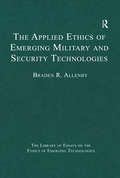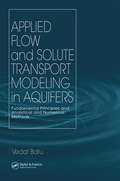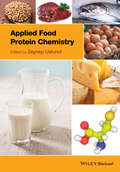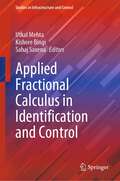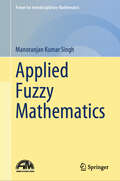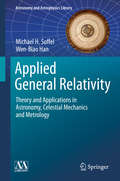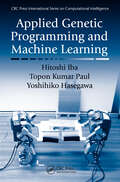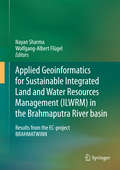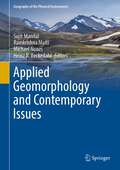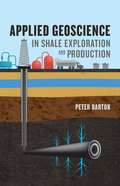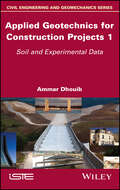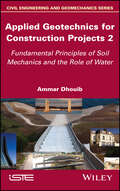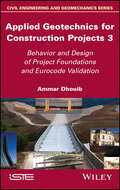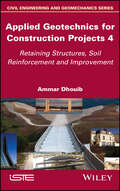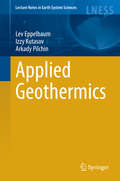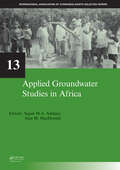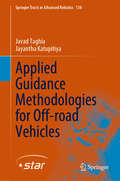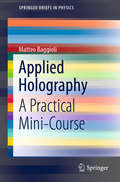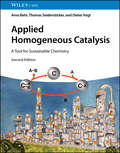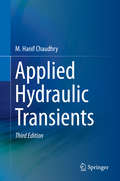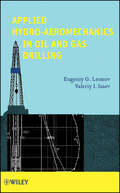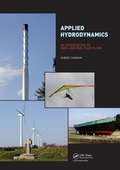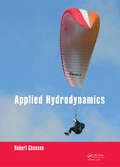- Table View
- List View
The Applied Ethics of Emerging Military and Security Technologies (The Library of Essays on the Ethics of Emerging Technologies)
by Braden R. AllenbyThe essays in this volume illustrate the difficult real world ethical questions and issues arising from accelerating technological change in the military and security domains, and place those challenges in the context of rapidly shifting geopolitical and strategic frameworks. Specific technologies such as autonomous robotic systems, unmanned aerial vehicles, cybersecurity and cyberconflict, and biotechnology are highlighted, but the essays are chosen so that the broader implications of fundamental systemic change are identified and addressed. Additionally, an important consideration with many of these technologies is that even if they are initially designed and intended for military or security applications, they inevitably spread to civil society, where their application may raise very different ethical questions around such core values as privacy, security from criminal behaviour, and state police power. Accordingly, this volume is of interest to students of military or security domains, as well as to those interested in technology and society, and the philosophy of technology.
Applied Flow and Solute Transport Modeling in Aquifers: Fundamental Principles and Analytical and Numerical Methods
by Vedat BatuOver recent years, important contributions on the topic of solving various aquifer problems have been presented in numerous papers and reports. The scattered and wide-ranging nature of this information has made finding solutions and best practices difficult. Comprehensive and self-contained, Applied Flow and Solute Transport Modeling in Aquifers co
Applied Food Protein Chemistry
by Zeynep UstunolFood proteins are of great interest, not only because of their nutritional importance and their functionality in foods, but also for their detrimental effects. Although proteins from milk, meats (including fish and poultry), eggs, cereals, legumes, and oilseeds have been the traditional sources of protein in the human diet, potentially any proteins from a biological source could serve as a food protein. The primary role of protein in the diet is to provide the building materials for the synthesis of muscle and other tissues, and they play a critical role in many biological processes. They are also responsible for food texture, color, and flavor. Today, food proteins are extracted, modified, and incorporated into processed foods to impart specific functional properties. They can also have adverse effects in the diet: proteins, such as walnuts, pecans, almonds, and cashews, soybean, wheat, milk, egg, crustacean, and fish proteins can be powerful allergens for some people.Applied Food Protein Chemistry is an applied reference which reviews the properties of food proteins and provides in-depth information on important plant and animal proteins consumed around the world. The book is grouped into three sections: (1) overview of food proteins, (2) plant proteins, and (3) animal proteins. Each chapter discusses world production, distribution, utilization, physicochemical properties, and the functional properties of each protein, as well as its food applications. The authors for each of the chapters are carefully selected experts in the field. This book will be a valuable reference tool for those who work on food proteins. It will also be an important text on applied food protein chemistry for upper-level students and graduate students of food science programs.
Applied Fractional Calculus in Identification and Control (Studies in Infrastructure and Control)
by Utkal Mehta Kishore Bingi Sahaj SaxenaThe book investigates the fractional calculus-based approaches and their benefits to adopting in complex real-time areas. Another objective is to provide initial solutions for new areas where fractional theory has yet to verify the expertise. The book focuses on the latest scientific interest and illustrates the basic idea of general fractional calculus with MATLAB codes. This book is ideal for researchers working on fractional calculus theory both in simulation and hardware. Researchers from academia and industry working or starting research in applied fractional calculus methods will find the book most useful. The scope of this book covers most of the theoretical and practical studies on linear and nonlinear systems using fractional-order integro-differential operators.
Applied Fuzzy Mathematics (Forum for Interdisciplinary Mathematics)
by Manoranjan Kumar SinghThis comprehensive introductory textbook is designed for undergraduate mathematics students who are interested in gaining an in-depth understanding of fuzzy mathematics and its applications. The book covers a wide range of topics, including fuzzy linear equations, fuzzy graphs, fuzzy measures, fuzzy logic, fuzzy topological spaces, fuzzy subgroups, as well as applications of fuzzy mathematics in various other fields. While readers are assumed to be familiar with the concept of fuzzy sets, the book maintains a clear and straightforward approach that makes it easy to follow for students at any level of proficiency. The advanced content is presented in an insightful and accessible manner, empowering students to apply the concepts they learn to real-world problems and applications. Enriched with over 105 solved examples, 133 challenging problems, 185 multiple-choice questions, and 150 true/false statements, this book is an ideal tool for beginners seeking to gain a solid foundation in fuzzy mathematics and its applications. Whether you are studying independently or as part of a classroom setting, this book provides a valuable resource that will help you achieve your goals.
Applied General Relativity: Theory and Applications in Astronomy, Celestial Mechanics and Metrology (Astronomy and Astrophysics Library)
by Michael H. Soffel Wen-Biao HanIn the late 20th and beginning 21st century high-precision astronomy, positioning and metrology strongly rely on general relativity. Supported by exercises and solutions this book offers graduate students and researchers entering those fields a self-contained and exhaustive but accessible treatment of applied general relativity. The book is written in a homogenous (graduate level textbook) style allowing the reader to understand the arguments step by step. It first introduces the mathematical and theoretical foundations of gravity theory and then concentrates on its general relativistic applications: clock rates, clock sychronization, establishment of time scales, astronomical references frames, relativistic astrometry, celestial mechanics and metrology. The authors present up-to-date relativistic models for applied techniques such as Satellite LASER Ranging (SLR), Lunar LASER Ranging (LLR), Globale Navigation Satellite Systems (GNSS), Very Large Baseline Interferometry (VLBI), radar measurements, gyroscopes and pulsar timing. A list of acronyms helps the reader keep an overview and a mathematical appendix provides required functions and terms.
Applied Genetic Algorithm and Its Variants: Case Studies and New Developments (Springer Tracts in Nature-Inspired Computing)
by Nilanjan DeyThis book provides fundamental concepts related to various types of genetic algorithms and practical applications in various domains such as medical imaging, manufacturing, and engineering design. The book discusses genetic algorithms which are used to solve a variety of optimization problems. The genetic algorithms are demonstrated to offer reliable search in complex spaces. The book presents high-quality research work by academics and researchers which is useful for young researchers and students.
Applied Genetic Programming and Machine Learning
by Hitoshi Iba Yoshihiko Hasegawa Topon Kumar PaulWhat do financial data prediction, day-trading rule development, and bio-marker selection have in common? They are just a few of the tasks that could potentially be resolved with genetic programming and machine learning techniques. Written by leaders in this field, Applied Genetic Programming and Machine Learning delineates the extension of Genetic
Applied Geoinformatics for Sustainable Integrated Land and Water Resources Management (ILWRM) in the Brahmaputra River basin: Results from the EC-project BRAHMATWINN
by Nayan Sharma Wolfgang-Albert FlügelThe central theme of this book is focused on the analyses and the results which emerged from the international research project BRAHMATWINN sponsored by European Commission (EC) and conducted during 2006 - 2009. The book highlights the achievements of BRAHMATWINN to carry out a harmonised integrated water resources management (IWRM) approach as addressed by the European Water Initiative (EWI) in headwater river systems of alpine mountain massifs. The latter are already impacted from climate change, and the BRAHMATWINN project established transfer of professional IWRM expertise, approaches and tools based on case studies carried out in twinning European and Asian river basins. The project addresses all important IWRM issues in a balanced way, including conflict resolution in the trans- boundary Danube and Brahmaputra River Basins in Europe and South Asia respectively. This book will be useful to researchers, professionals, managers and decision makers associated with study and application of sustainable integrated land and water resources management (ILWRM) in the backdrop of climate change.
Applied Geology: Approaches to Future Resource Management
by Marina De Maio Ashwani Kumar TiwariThis book includes a careful selection of significant contributions from international experts that were presented at the 6th AIGA Conference “Applied Geology: Approaches to Future Resource Management” that was held in the Courmayeur, Aosta Valley, Italy, from 27 - 29 June 2018. The following 7 areas are the main themes covered in this volume: · Applied Geology · Hydrogeology · Geological Exploration (underground) · Slope Instability, · Natural Hazards, Risk Assessment and Management, · Geo-resources and Sustainable Development · Application of Remote Sensing and Geographical Information Systems (GIS) The authors, from academia, research and industry present the latest state of the practice, new technologies, innovative methods and sustainable management in the field of Applied and Environmental Geology. This carefully edited work will be of value to academia, professionals, scientists and decision makers.
Applied Geomorphology and Contemporary Issues (Geography of the Physical Environment)
by Sujit Mandal Ramkrishna Maiti Michael Nones Heinz R. BeckedahlThe edited book deals with climate change and its response to river system which is one of the most burning issues of the Global environment. Due to urbanization and industrialization land degradation and resource depletion are happening and promoting livelihood challenges in the world which is reflected in the book too. The book addresses the construction of dams over large rivers and its possible consequences in the environment. Changes of the hydrology and sedimentology are to be addressed in the book. The climate change phenomena and associated geomorphic hazards and contemporary environmental issues such as sea level rise, coastal flood, drought, wind erosion, flood, soil erosion, landslide, depletion of ground water, coastal erosion etc. are elaborated in the book with suitable methods and techniques. So this edited book will contribute a lot to general to particular filed of studies and will help to geographers, geomorphologists, environmentalists, planners, policy makers and developers for studies and promoting regional plans and development.
Applied Geoscience in Shale Exploration and Production
by Peter BartokSince the year 2000, unconventional shale plays have contributed greatly to the global oil and gas supply, particularly in the United States. Understanding and managing these resources requires a unique understanding about the geology, geophysics, rock physics, and rock mechanics of each reservoir in a seamless interdisciplinary approach. Equally important, advanced technologies in seismic and microseismic processing enable professionals to map and identify the hydrocarbon resource and establish the optimum pathways for production.
Applied Geotechnics for Construction Projects, Volume 1: Soil and Experimental Data
by Ammar DhouibApplied Geotechnics for Construction Projects, Volume 1: Soil and Experimental Data
Applied Geotechnics for Construction Projects, Volume 2: Fundamental Principles of Soil Mechanics and the Role of Water
by Ammar DhouibApplied Geotechnics for Construction Projects, Volume 2: Fundamental Principles of Soil Mechanics and the Role of Water
Applied Geotechnics for Construction Projects, Volume 3: Behavior and Design of Project Foundations and Eurocode Validation
by Ammar DhouibApplied Geotechnics for Construction Projects, Volume 3: Behavior and Design of Project Foundations and Eurocode Validation
Applied Geotechnics for Construction Projects, Volume 4: Retaining Structures, Soil Reinforcement and Improvement
by Ammar DhouibApplied Geotechnics for Construction Projects, Volume 4: Retaining Structures, Soil Reinforcement and Improvement
Applied Geothermics (Lecture Notes in Earth System Sciences)
by Lev Eppelbaum Izzy Kutasov Arkady PilchinThis book describes origin and characteristics of the Earth's thermal field, thermal flow propagation and some thermal phenomena in the Earth. Description of thermal properties of rocks and methods of thermal field measurements in boreholes, underground, at near-surface conditions enables to understand the principles of temperature field acquisition and geothermal model development. Processing and interpretation of geothermal data are shown on numerous field examples from different regions of the world. The book warps, for instance, such fields as analysis of thermal regime of the Earth's crust, evolution and thermodynamic conditions of the magma-ocean and early Earth atmosphere, thermal properties of permafrost, thermal waters, geysers and mud volcanoes, methods of Curie discontinuity construction, quantitative interpretation of thermal anomalies, examination of some nonlinear effects, and integration of geothermal data with other geophysical methods. This book is intended for students and researchers in the field of Earth Sciences and Environment studying thermal processes in the Earth and in the subsurface. It will be useful for specialists applying thermal field analysis in petroleum, water and ore geophysics, environmental and ecological studies, archaeological prospection and climate of the past.
Applied Groundwater Studies in Africa: IAH Selected Papers on Hydrogeology, volume 13
by Segun Adelana Alan MacDonaldGroundwater is Africa‘s most precious natural resource, providing reliable water supplies for many people. Further development of groundwater resources is fundamental to increasing access to safe water across the continent to meet coverage targets and reduce poverty. There is also an increasing interest in the use of groundwater for irrigated
Applied Guidance Methodologies for Off-road Vehicles (Springer Tracts in Advanced Robotics #138)
by Javad Taghia Jayantha KatupitiyaThis book provides methodologies for designing and implementing guidance algorithms for autonomous vehicles. These algorithms make important decision regarding how to steer and drive a ground vehicle in order to safely stay on an intended path, thereby making the vehicle driverless. The design tools provided in this book enable the reader to develop highly practical and real-world implementable guidance algorithms that will deliver high-accuracy driving for field vehicles. (They are equally applicable for on-road vehicles.) The book covers a variety of vehicle types, including wheeled vehicles, tracked vehicles, wheeled and tracked vehicles towing trailers, and four-wheel-steer and four-wheel-drive vehicles. It also covers active trailers that are driven and steered. Vehicles used in agriculture, mining and road construction are subjected to unpredictable and significant disturbances. The robust control methodologies presented can successfully compensate for these disturbances, as confirmed by the experimental results presented. Though the majority of the methodologies presented are based on sliding-mode controllers, other robust control methodologies are also discussed. To help the reader decide which controller is best suited for his/her choice of vehicle, experimental results are presented in a comparative format.
Applied Holography: A Practical Mini-Course (SpringerBriefs in Physics)
by Matteo BaggioliThis primer is a collection of notes based on lectures that were originally given at IIT Madras (India) and at IFT Madrid (Spain). It is a concise and pragmatic course on applied holography focusing on the basic analytic and numerical techniques involved. The presented lectures are not intended to provide all the fundamental theoretical background, which can be found in the available literature, but they concentrate on concrete applications of AdS/CFT to hydrodynamics, quantum chromodynamics and condensed matter. The idea is to accompany the reader step by step through the various benchmark examples with a classmate attitude, providing details for the computations and open-source numerical codes in Mathematica, and sharing simple tricks and warnings collected during the author’s research experience. At the end of this path, the reader will be in possess of all the fundamental skills and tools to learn by him/herself more advanced techniques and to produce independent and novel research in the field.
Applied Homogeneous Catalysis: A Tool for Sustainable Chemistry
by Arno Behr Thomas Seidensticker Dieter VogtOne-stop reference on homogeneous catalysis, from general concepts through detailed examples and industrial applications Accessible and richly illustrated, Applied Homogeneous Catalysis provides a concise overview of the broad field of homogeneous transition metal catalysis and its applications in the chemical industry. This newly revised and updated second edition puts special emphasis on green chemistry, sustainable resources, and processes. The book is divided into five parts. Part I presents the basics of transition metal catalysis. Part II focuses on process engineering aspects. Part III provides details of the most important catalytic reactions. Part IV describes catalytic conversions closely related to classical homogeneous transition metal catalysis, such as nano-, electro-, photo- and organocatalysis. Part V covers new feedstocks and other topics, concluding with an outlook on future challenges of homogeneous catalysis. The book contains numerous mechanistic details, technical information, and illustrative examples. The chapters are enlivened by various excursions that relate the content to everyday life or introduce important personalities. Didactically, the book is completed with learning objectives and take-home messages for each chapter, as well as more than 400 questions and answers for self-testing. Written by a team of internationally renowned experts in the field, with a wealth of experience in industry and teaching, Applied Homogeneous Catalysis includes information on: Economic importance of industrial homogeneously-catalyzed reactions and basics of organometallic chemistry, including types of bonds, elemental steps, and mechanisms Common approaches for separating the homogeneous catalyst from the products after the reaction and using combinatorial chemistry and high throughput screening to achieve optimal results Activating “inactive” molecules such as carbon dioxide and nitrogen, and harnessing homogeneous catalysis for feedstock diversification by recycling polymers or using renewables. Providing expansive coverage of the subject, Applied Homogeneous Catalysis is an essential guide for researchers and professionals in the pharmaceutical, polymer, and fine and bulk chemicals industries working on catalysis or entering the field, as well as for Master’s and PhD students in organic chemistry, chemical engineering, and related fields.
Applied Hydraulic Transients
by M. Hanif ChaudhryApplied Hydraulic Transients, 3rd Edition covers hydraulic transients in a comprehensive and systematic manner from introduction to advanced level and presents various methods of analysis for computer solution. The book is suitable as a textbook for senior-level undergraduate and graduate students as well as a reference for practicing engineers and researchers. The field of application of the book is very broad and diverse and covers areas such as hydroelectric projects, pumped storage schemes, water-supply systems, cooling-water systems, oil pipelines and industrial piping systems. A strong emphasis is given to practical applications: several case studies, problems of applied nature, and design criteria are included. This will help the design engineers and introduce the students to real-life projects. Up-to-date references are included at the end of each chapter.
Applied Hydro-Aeromechanics in Oil and Gas Drilling
by Eugeniy G. Leonov Valeriy I. IsaevHydromechanical processes underlie the majority of technology operations in drilling, and present a crucial concern as the pace and depth of drilling increases in today's energy-hungry world. Applied Hydroaeromechanics in Oil and Gas Drilling offers a unique resource for properly modeling and understanding the hydrodynamic forces affecting a drilling site. Combining hydrodynamic theory with specific drilling applications, this coverage provides readers with a comprehensive reference for designing, planning, and optimizing drilling operations.
Applied Hydrodynamics: An Introduction to Ideal and Real Fluid Flows
by Hubert ChansonFluid dynamics is the engineering science dealing with forces and energies generated by fluids in motion. Fluid dynamics and hydrodynamics play a vital role in everyday life. Practical examples include the flow motion in the kitchen sink, the exhaust fan above the stove, and the air conditioning system in our home. When driving a car, the air flow
Applied Hydrodynamics: An Introduction
by Hubert ChansonThis textbook treats Hydro- and Fluid Dynamics, the engineering science dealing with forces and energies generated by fluids in motion, playing a vital role in everyday life. Practical examples include the flow motion in the kitchen sink, the exhaust fan above the stove, and the air conditioning system in our home. When driving a car, the air flow
